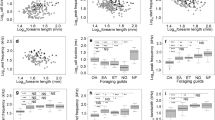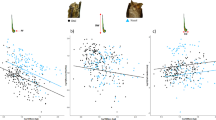Abstract
The peak echolocation frequency of insectivorous bats generally declines as body size increases. However, there are notable exceptions to this rule, with some species, such as Rhinolophus clivosus, having a higher than expected peak frequency for their body size. Such deviations from allometry may be associated with partitioning of foraging habitat (the foraging habitat hypothesis) or insect prey (the prey detection hypothesis). Alternatively, the deviations may be associated with the partitioning of sonar frequency bands to allow effective communication in a social context (the acoustic communication hypothesis). We tested the predictions of these hypotheses through comparisons at the family, clade and species level, using species of rhinolophids in general and R. clivosus, a species with a wide distribution, as a specific test case. We compared the wing parameters, echolocation frequency and ecology of R. clivosus to those of the sympatric R. capensis. Rhinolophus clivosus has a much higher echolocation frequency than predicted from its wing loading or body mass. Furthermore, contrary to the predictions of the foraging habitat hypothesis, we found no difference in foraging habitat between R. clivosus and R. capensis. The size range of insect prey taken by the two species also overlapped almost completely, contrary to the prey detection hypothesis. On the other hand, the variation of echolocation frequencies around the allometric relationship for rhinolophids was smaller than that for Myotis spp., supporting the prediction of the acoustic communication hypothesis. We thus propose that the relatively high peak frequency of R. clivosus is the result of partitioning of sonar frequency bands to minimize the ambiguity of echolocation calls during social interactions.




Similar content being viewed by others
References
Aldridge HDJN, Rautenbach IL (1987) Morphology, echolocation and resource partitioning in insectivorous bats. J Anim Ecol 56:763–778
Anthony EL (1988) Age determination in bats. In: Kunz TH (ed) Ecological and behavioral methods for the study of bats. Smithsonian Institute Press, Washington, DC, Ch 3
Barclay RMR (1982) Inter-individual use of echolocation calls: eavesdropping by bats. Behav Ecol Sociobiol 10:271–275
Barclay RMR (1986) The echolocation calls of hoary (Lasiurus cinereus) and silver-haired (Lasionycteris noctivagans) bats as adaptations for long- versus short-range foraging strategies and the consequences for prey selection. Can J Zool 64:2700–2705
Barclay RMR, Brigham RM (1991) Prey detection, dietary niche breadth, and body size in bats: why are aerial insectivorous bats so small? Am Nat 137:693–703
Bell GP, Fenton MB (1984) The use of Doppler-shifted echoes as a clutter rejection system: the echolocation and feeding behaviour of Hipposideros rubber (Chiropetra: Hipposideridae). Behav Ecol Sociobiol 15:109–114
Csorba G, Ujhelyi P, Thomas N (2003) Horseshoe bats of the world. Alana Books, Bishop’s Castle, Shropshire, UK
Denzinger A, Kalko EKV, Jones G (2004) Ecological and evolutionary aspects of echolocation in bats. In: Thomas JA, Moss CF, Vater M (eds) Echolocation in bats and dolphins. University of Chicago Press, Chicago, IL, pp 311–326
Dietz C (2005) Illustrated identification key to the bats of Egypt (electronic publication, v1.0, released 21/12/2005). C. Dietz, University of Tuebingen. Accessed February 8, 2007. http://www.uni-tuebingen.de/tierphys/Kontakt/mitarbeiter_seiten/dietz.htm
Duellman WE, Pyles RA (1983) Acoustic resource partitioning in anuran communities. Copeia 1983:639–649
Faure PA, Barclay RMR (1994) Substrate-gleaning versus aerial-hawking: plasticity in the foraging and echolocation behavior of the long-eared bat, Myotis evotis. J Comp Physiol A 174:651–660
Fenton MB (1990) The foraging behaviour and ecology of animal-eating bats. Can J Zool 80:1004–1013
Fenton MB (2004) Aerial-feeding bats: getting the most out of echolocation. In: Thomas JA, Moss CF, Vater M (eds) Echolocation in bats and dolphins. University of Chicago Press, Chicago, IL, pp 350–355
Fenton MB, Bell GP (1979) Echolocation and feeding behaviour of four species of Myotis (Chiroptera). Can J Zool 57:1271–1277
Fenton MB, Bell GP (1981) Recognition of species of insectivorous bats by their echolocation calls. J Mammal 62:233–243
Fenton MB, Bogdanowicz W (2002) Relationships between external morphology and foraging behaviour: bats in the genus Myotis. Can J Zool 80:1004–1013
Fenton MB, Fullard JH (1979) The influence of moth hearing on bat echolocation strategies. J Comp Physiol 132:77–86
Fenton MB, Portfors CV, Rautenbach IL, Waterman JM (1998) Compromises: sound frequencies used in echolocation by aerial-feeding bats. Can J Zool 70:1174–1182
Fenton MB, Rydell J, Vonhof MJ, Eklöf J, Lancaster WC (1999) Constant-frequency and frequency-modulated components in the echolocation calls of three species of small bats (Emballonuridae, Thyropteridae and Vespertilionidae). Can J Zool 77:1891–1900
Fullard JH (1982) Echolocating assemblages and the effects on moth auditory systems. Can J Zool 60:2572–2576
Gannon WL, Sherwin RE, deCarvalho TN, O’Farrell MJ (2001) Pinnae and echolocation call differences between Myotis californicus and M. ciliolabrum (Chiroptera: Vespertilionidae). Acta Chiropt 3:77–91
Guillén A, Juste BJ, Ibáñez G (2000) Variation in the frequency of the echolocation calls of Hipposideros ruber in the Gulf of Guinea: an exploration of the adaptive meaning of the constant frequency value in rhinolophid CF bats. J Evol Biol 13:70–80
Guillén A, Francis CM, Ricklefs RE (2003) Phylogeny and biogeography of the horseshoe bats. In: Csorba G, Ujhelyi P, Thomas N (eds) Horseshoe bats of the world. Alana Books, Bishop’s Castle, Shropshire, UK, pp 12–24
Hartley DJ, Suthers RA (1988) The acoustics of the vocal tract in the horseshoe bat, Rhinolophus hildebrandti. J Acoust Soc Am 84:1201–1213
Heller K-G, von Helversen O (1989) Resource partitioning of sonar frequency bands in rhinolophoid bats. Oecologia 80:178–186
Houston RD, Boonman AM, Jones G (2004) Do echolocation signal parameters restrict bats’ choice of prey? In: Thomas JA, Moss CF, Vater M (eds) Echolocation in bats and dolphins. University of Chicago Press, Chicago, IL, pp 339–345
Jacobs DS (2000) Community level support for the allotonic frequency hypothesis. Acta Chiropt 2:197–207
Jones G (1992) Bats vs moths: studies on the diets of rhinolophid and hipposiderid bats support the allotonic frequency hypothesis. In: Horáčeck I, Vohralik V (eds) Prague studies in mammalogy. Charles University Press, Prague, Czech Republic, pp 87–92
Jones G (1996) Does echolocation constrain the evolution of body size in bats? In: Miller PJ (ed) Miniature vertebrates: the implications of small vertebrates. Symp Zool Soc Lond 69:111–128
Jones G (1999) Scaling of echolocation call parameters in bats. J Exp Biol 202:3350–3367
Jones G, Barlow KE (2004) Cryptic species of echolocating bats. In: Thomas JA, Moss CF, Vater M (eds) Echolocation in bats and dolphins. University of Chicago Press, Chicago, IL, pp 345– 349
Jones G, Gordon T, Nightingale J (1992) Sex and age differences in the echolocation calls of the lesser horseshoe bat, Rhinolophus hipposideros. Mammalia 56:189–193
Kingston T, Rossiter SJ (2004) Harmonic-hopping in Wallacea’s bats. Nature 429:654–657
Kingston T, Jones G, Zubaid A, Kunz TH (2000) Resource partitioning in rhinolophid bats revisited. Oecologia 124:332–342
Martins EP (2004) COMPARE, version 4.6b. E.P. Martins, Department of Biology, Indiana University, Bloomington, IN. Accessed on February 8, 2007. http://compare.bio.indiana.edu/
Martins EP, Hansen TF (1997) Phylogenies and the comparative method: a general approach to incorporating phylogenetic information into the analyses of interspecific data. Am Nat 149:646–667
Miller-Butterworth CM, Eick GN, Jacobs DS, Schoeman MC, Harley EH (2005) Genetic and phenotypic differences between natal- and lesser long-fingered bats, Miniopterus natalensis and M. fraterculus (Chiroptera, Vespertilionidae), and a global miniopterine phylogeny. J Mammal 86:1121–1135
Möhres FP (1967) Communicative characters of sonar signals in bats. In: Busnel RG (ed) Les systemes sonars animaux, vol 2. NATO Advanced Study Institute, Frascati
Neuweiler G (1984) Foraging, echolocation and audition in bats. Naturwissenschaften 71:446–455
Neuweiler G (1990) Auditory adaptations for prey capture in echolocating bats. Physiol Rev 70:615–641
Neuweiler G, Metzner W, Heilmann U, Rübsamen R, Eckrich M, Costa HH (1987) Foraging behaviour and echolocation in the rufous horseshoe bat (Rhinolophous rouxi) of Sri Lanka. Behav Ecol Sociobiol 20:53–67
Norberg UM, Rayner JMV (1987) Ecological morphology and flight in bats (Mammalia: Chiroptera): wing adaptations, flight performance, foraging strategy and eecholocation. Philos Trans Roy Soc Lond B Biol Sci 316:335–427
Novick A (1977) Acoustic orientation. In: Wimsatt WA (ed) Biology of bats, vol 3. Academic, New York, pp 73–287
Obrist MK, Boesch R, Flückiger PF (2004) Variability in echolocation call design of 26 Swiss bat species: consequences, limits and options for automated field identification with a synergetic pattern recognition approach. Mammalia 68:307–322
O’Farrell MJ, Miller BW, Gannon WL (1999) Qualitative identification of free-flying bats using the Anabat detector. J Mammal 80:11–23
Pye JD (1983) Echolocation and countermeasures. In: Lewis B (ed) Bioacoustics. A comparative approach. Academic, New York, pp 407–429
Russo D, Jones G, Mucedda M (2001) Influence of age, sex and body size on echolocation call of Mediteranean and Mehely’s horseshoe bats, Rhinolophus euryale and R. mehelyi (Chiroptera: Rhinolophidae). Mammalia 65:429–436
Saunders MB, Barclay RMR (1992) Ecomorphology of insectivorous bats: a test of predictions using two morphologically similar species. Ecology 73:1335–1345
Schnitzler H-U, Ostwald J (1983) Adaptations for the detection of fluttering insects by echolocation in horseshoe bats. In: Ewert JP, Capranica RR, Ingle DI (eds) Advances in vertebrate neuroethology. Plenum, New York, pp 801–827
Scholtz CH, Holm E (1985) Insects of southern Africa. University of Pretoria, Pretoria
Siemers BM, Schnitzler H-U (2004) Echolocation signals reflect niche differentiation in five sympatric congeneric bat species. Nature 429:657–661
Siemers BM, Beedholm K, Dietz C, Dietz I, Ivanova T (2005) Is species identity, sex, age or individual quality conveyed by echolocation call frequency in European horseshoe bats? Acta Chiropt 7:259–274
Stoffberg S (2006) The systematics and evolution of echolocation in the genus Rhinolophus. Ph.D. Thesis, University of Cape Town, South Africa
Taylor PJ (2000) Bats of southern Africa. University of Natal Press, Pietermaritzburg
Thabah A, Rossiter SJ, Kingston T, Zhang S, Parsons S, Mya My K, Zubaid A, Jones G (2006) Genetic divergence and echolocation call frequency in cryptic species of Hipposideros larvatus s. l. (Chiroptera: Hipposideridae) from the Indo-Malayan region. Biol J Linn Soc Lond 88:119–130
Thomas DW, Bell GP, Fenton MB (1987) Variation in echolocation call frequencies recorded from North American vespertilionid bats: a cautionary note. J Mammal 68:842–847
Vater M (1987) Narrow-band frequency analysis in bats. In: Fenton MB, Racey P, Rayner JMV (eds) Recent advances in the study of bats. Cambridge University Press, Cambridge, pp 200–225
Waters DA, Rydell J, Jones G (1995) Echolocation call design and limits on prey size: a case study using the aerial-hawking bat Nyctalus leisleri. Behav Ecol Sociobiol 37:321–328
Whitaker JO (1988) Food habits analysis of insectivorous bats. In: Kunz TH (ed) Ecological and behavioral methods for the study of bats. Smithsonian Institute Press, Washington, DC, Ch 3
Woodsworth GC, Bell GP, Fenton MB (1981) Observations of the echolocation, feeding behavior, and habitat use of Euderma maculatum (Chiroptera: Vespertilionidae) in south central British Columbia. Can J Zool 59:1099–1102
Acknowledgments
We thank students of the 2005 Behavioural Ecology course for help in the field, M. C. Schoeman for help with statistical analyses, and M. Brigham and two anonymous reviewers for commenting on an earlier version of this manuscript. This study was funded by research grants from the University of Cape Town and the National Research Foundation of South Africa to DSJ (GUN 2053611), from the University of Calgary and the Natural Sciences and Engineering Research Council of Canada to RMRB, and a Fulbright Fellowship to MHW. All work in this study complies with the current laws of South Africa.
Author information
Authors and Affiliations
Corresponding author
Additional information
Communicated by Jörg Ganzhorn.
Rights and permissions
About this article
Cite this article
Jacobs, D.S., Barclay, R.M.R. & Walker, M.H. The allometry of echolocation call frequencies of insectivorous bats: why do some species deviate from the pattern?. Oecologia 152, 583–594 (2007). https://doi.org/10.1007/s00442-007-0679-1
Received:
Accepted:
Published:
Issue Date:
DOI: https://doi.org/10.1007/s00442-007-0679-1




